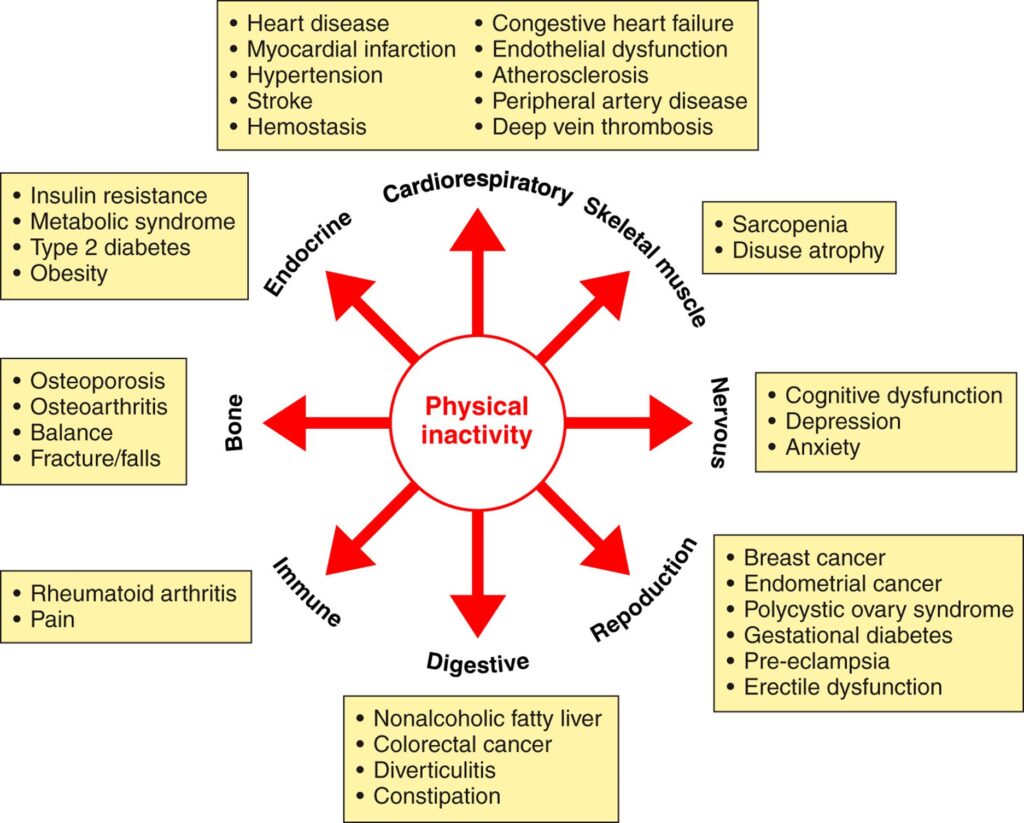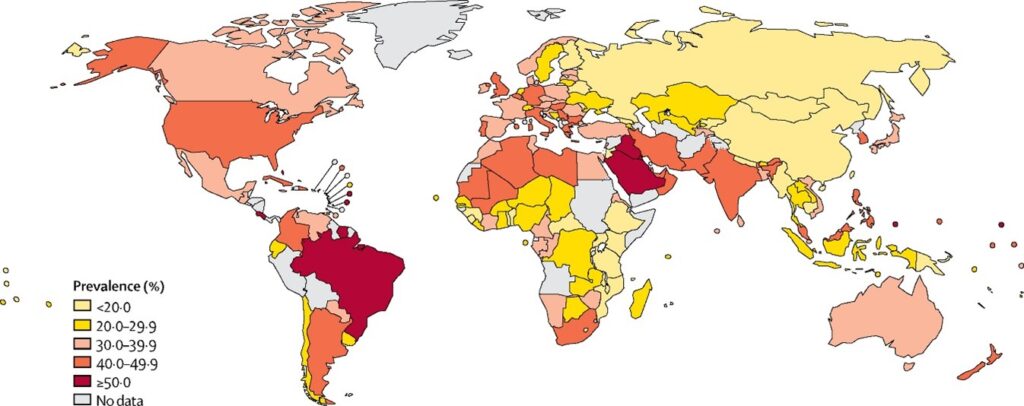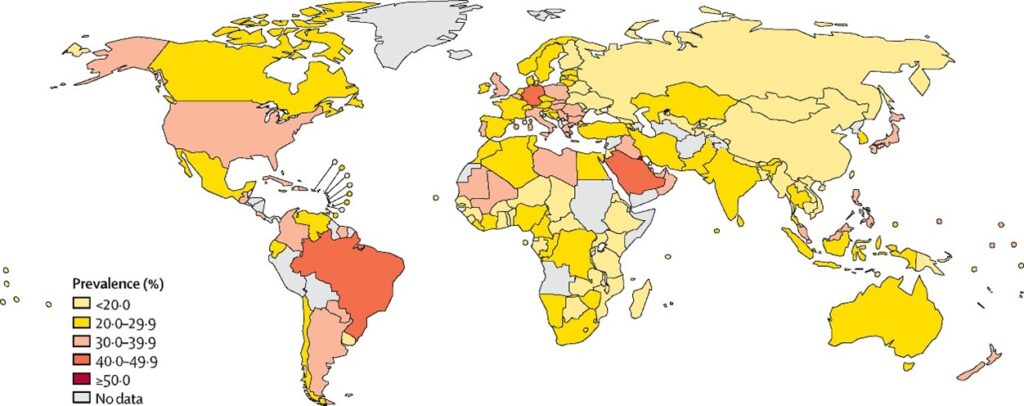Dr. Pubali Biswas, MBBS
“Sitting has become the new smoking of our generation.” – Nilofer Merchant.
In today’s fast-paced world, technology has made our lives easier and more comfortable than ever before. With the rise of technology and its integration into our daily lives, many jobs now require employees to sit at a desk for extended periods. Many jobs that require physical labor have been replaced by automation. Rapid urbanization has led to constructing cities designed for cars, not pedestrians or cyclists. Busy lifestyles with long work hours, longer commutes, and the pressure to juggle multiple responsibilities have made finding time for physical exercise challenging.
Most people entertain themselves with leisure activities that often involve sitting for extended periods before a screen. This sedentary lifestyle may seem safe to unwind and relax, but it is a silent, insidious killer.
The price we pay for this lifestyle comes at the cost of our health. Lack of physical activity has become a major public health concern, contributing to a range of health problems, including obesity, heart disease, and diabetes. The negative effects of a sedentary lifestyle are not limited to physical health alone, it also has a negative impact on cognitive function and brain health leading to stress, anxiety and depression.
- Sedentary behavior more than just physical inactivity?
The terms “sedentary lifestyle” and “physical inactivity” are often used interchangeably but have different meanings.
Physical inactivity refers to a lack of physical activity. Sedentary Behaviour Research Network defines inactivity as a person performing insufficient amounts of moderate and vigorous intensity activity (MVPA), i.e. not meeting specified physical activity guidelines. [1][2] The WHO global recommendations on physical activity for health state that “Adults aged 18–64 years should do at least 150 min of moderate-intensity aerobic physical activity throughout the week or do at least 75 min of vigorous-intensity aerobic physical activity throughout the week, or an equivalent combination of moderate and vigorous-intensity activity (MVPA).” [3]
On the other hand, sedentary behavior refers to any waking activity characterized by low levels of energy expenditure. Sedentary behavior can include activities such as sitting at a desk, watching TV, using a computer, driving, and reading.
However, it is important to note that both lead to detrimental effects on health.
- The vicious cycle of sedentary lifestyle

Figure 1. Vicious cycle of physical inactivity [4]
Sedentary behavior has been associated with increased risk of depression, anxiety, and stress. A lack of physical activity can cause changes in the brain that impact our mood and emotional wellbeing. At the same time, these negative emotions can make it more challenging to engage in physical activity, leading to a vicious cycle of inactivity and negative emotions.
It also contributes to poor sleep quality, which exacerbates mental health issues. Symptoms of poor sleep like fatigue, irritability, and low concentration can make it more challenging to find the motivation to engage in physical activity. Physical activity is often a social activity, and a lack of it can lead to feelings of isolation and loneliness, further leading to a cycle of inactivity and social withdrawal.
- Health conditions attributed to sedentary lifestyle
Regular physical activity has been associated with decreased adiposity, increase in muscle oxidative potential and resting metabolism, decrease in energy intake relative to energy expenditure and an increase in beta-adrenergic stimulation. Lack of this balance can lead to several non-communicable diseases. (NCD). [5]
According to a study published in The Lancet, the global impact of physical inactivity on the burden of disease for coronary heart disease was estimated to be 6%, 7% for type 2 diabetes, 10% for breast cancer, and 10% for colon cancer. Of the 57 million deaths globally in 2008, 9% of premature mortality (more than 5.3 million) was attributed to inactivity. [7]
There have been 35 (NCD) associated with sedentary lifestyle.

Figure 2. Diseases associated with physical inactivity [6]
The WHO Guideline developmental Group (GDG) 2010 concluded that – [3]
- There is intermediate certainty evidence that sedentary behavior is linked to higher all-cause mortality rates, cardiovascular disease mortality, cancer mortality and type 2 diabetes incidence.
- Evidence shows, with low to moderate certainty, sedentary activity increases the chance of developing endometrial, colon, and lung cancers.
- Insufficient data is present to draw a firm conclusion about the relationship between sedentary behavior and adiposity.
- The benefits of limiting sedentary behavior outweigh any potential risks.
- The Global burden of inactivity
A study titled “Global trends in insufficient physical activity from 2001 to 2016: a pooled analysis of 358 population-based surveys with 19 million participants” was published in The Lancet. Data from roughly 2 million participants (representing 96% of the world’s population) suggested that more than a quarter of adults worldwide did not engage in enough physical activity in 2016, putting more than 1.4 billion adults at risk of contracting or worsening diseases associated with inactivity. [9]
Another investigation, published in 2022, compared premature mortality and several NCDs linked to low physical activity (LPA). The study aimed to evaluate the global disease burden and changes in LPA-related illnesses (DALPA) from 1990 to 2019. The results showed that the age-standardized DALYs and DALPA death rates were 198.42/100,000 and 11.10/100,000, respectively, globally in 2019. LPA was responsible for 15.74 million (8.51-28.61) DALYs and 0.83 million (0.43-1.47) fatalities. [8]

Figure 3. Country prevalence of insufficient physical activity in women in 2016 [9]

Figure 4. Country prevalence of insufficient physical activity in men in 2016 [9]
- Physical inactivity in India
India, like most countries is also experiencing a rapid lifestyle transition with a rising burden of Non-Communicable Diseases (NCD) surpassing the burden of Communicable diseases and is estimated to account for around 60% of all deaths.
Results from the ICMR-INDIAB study (Phase-1) conducted in four regions in India (2014) showed that [11]
- 54.4% of the target population in the study were inactive, while 31.9% were active and 13.7% were highly active.
- Subjects were more inactive in urban, compared to rural areas.
- Males were significantly more active than females (p<0.001)
- Prevention is better than cure
It is much easier to prevent health problems associated with physical inactivity than to treat them once they have developed. The WHO recommendation to prevent sedentary lifestyle include –

Figure 5. WHO recommendation of physical activity [3]
In India, to prevent and control major NCDs, the National Programme for Prevention and Control of Cancer, Diabetes, Cardiovascular Diseases and Stroke (NPCDCS) was launched in 2010 with focus on strengthening infrastructure, human resource development, health promotion, early diagnosis, management and referral. Primary prevention mainly targets enhancing health through behavior modification within community via increase in awareness. Various screening centers have been set up in over 21 states in the country for early detection of NCD. [10]
- Conclusion
The lifestyle of convenience has consumed a majority of our population today. We are currently living in a pandemic of sedentary life. Most of us fail to realize that this way of living is a ticking bomb inside of us, waiting to explode, destroying almost every organ of the human body. Even a minute addition of physical activity can reduce the risk of multiple health problems and improve our overall well-being.
By decreasing inactivity from 10% more than 533,000 deaths could be averted every year. It is estimated that elimination of physical inactivity would increase the life expectancy of the world’s population by 0·68 (range 0·41-0·95) years. [7]
References
- Sedentary Behaviour Research Network. Letter to the editor: standardized use of the terms “sedentary” and “sedentary behaviours.”. Appl Physiol Nutr Metab. 2012;37:540–2
- van der Ploeg, H.P., Hillsdon, M. Is sedentary behaviour just physical inactivity by another name?. Int J Behav Nutr Phys Act 14, 142 (2017). https://doi.org/10.1186/s12966-017-0601-0
- World Health Organisation. Global recommendations on physical activity for health. Geneva: World Health Organisation; 2010
- Gualano, Bruno & Bonfa, Eloisa & Pareira, Rosa & Silva, Clovis. (2017). Physical activity for paediatric rheumatic diseases: Standing up against old paradigms. Nature Reviews Rheumatology. 13. 368-379. 10.1038/nrrheum.2017.75.
- Panahi S, Tremblay A. Sedentariness and Health: Is Sedentary Behavior More Than Just Physical Inactivity? Front Public Health. 2018 Sep 10;6:258. doi: 10.3389/fpubh.2018.00258. PMID: 30250838; PMCID: PMC6139309.
- Booth, F. W., Roberts, C. K., Thyfault, J. P., Ruegsegger, G. N., & Toedebusch, R. G. (2017). Role of Inactivity in Chronic Diseases: Evolutionary Insight and Pathophysiological Mechanisms. Physiological Reviews. https://doi.org/PRV-00019-2016
- Lee IM, Shiroma EJ, Lobelo F, Puska P, Blair SN, Katzmarzyk PT; Lancet Physical Activity Series Working Group. Effect of physical inactivity on major non-communicable diseases worldwide: an analysis of burden of disease and life expectancy. Lancet. 2012 Jul 21;380(9838):219-29. doi: 10.1016/S0140-6736(12)61031-9. PMID: 22818936; PMCID: PMC3645500.
- Xu YY, Xie J, Yin H, Yang FF, Ma CM, Yang BY, Wan R, Guo B, Chen LD, Li SL. The Global Burden of Disease attributable to low physical activity and its trends from 1990 to 2019: An analysis of the Global Burden of Disease study. Front Public Health. 2022 Dec 15;10:1018866. doi: 10.3389/fpubh.2022.1018866. PMID: 36590002; PMCID: PMC9798308.
- Worldwide trends in insufficient physical activity from 2001 to 2016: a pooled analysis of 358 population-based surveys with 1·9 million participants, Guthold, Regina et al. The Lancet Global Health, Volume 6, Issue 10, e1077 – e1086
- https://nhm.gov.in/index1.php?lang=1&level=2&sublinkid=1048&lid=604
- Anjana RM, Pradeepa R, Das AK, Deepa M, Bhansali A, Joshi SR, Joshi PP, Dhandhania VK, Rao PV, Sudha V, Subashini R, Unnikrishnan R, Madhu SV, Kaur T, Mohan V, Shukla DK; ICMR– INDIAB Collaborative Study Group. Physical activity and inactivity patterns in India – results from the ICMR-INDIAB study (Phase-1) [ICMR-INDIAB-5]. Int J Behav Nutr Phys Act. 2014 Feb 26;11(1):26. doi: 10.1186/1479-5868-11-26. PMID: 24571915; PMCID: PMC3974063
contact information
write us or contact us on our social media
Please set the ‘Contact Form’ component shortcode
contact information
write us or contact us on our social media
Please set the ‘Contact Form’ component shortcode
contact information
write us or contact us on our social media
Please set the ‘Contact Form’ component shortcode
contact information
write us or contact us on our social media
Please set the ‘Contact Form’ component shortcode
contact information
write us or contact us on our social media
Please set the ‘Contact Form’ component shortcode
contact information
write us or contact us on our social media
Please set the ‘Contact Form’ component shortcode
contact information
write us or contact us on our social media
Please set the ‘Contact Form’ component shortcode
contact information
write us or contact us on our social media
Please set the ‘Contact Form’ component shortcode
contact information
write us or contact us on our social media
Please set the ‘Contact Form’ component shortcode
contact information
write us or contact us on our social media
Please set the ‘Contact Form’ component shortcode
contact information
write us or contact us on our social media
Please set the ‘Contact Form’ component shortcode
contact information
write us or contact us on our social media
Please set the ‘Contact Form’ component shortcode

No responses yet